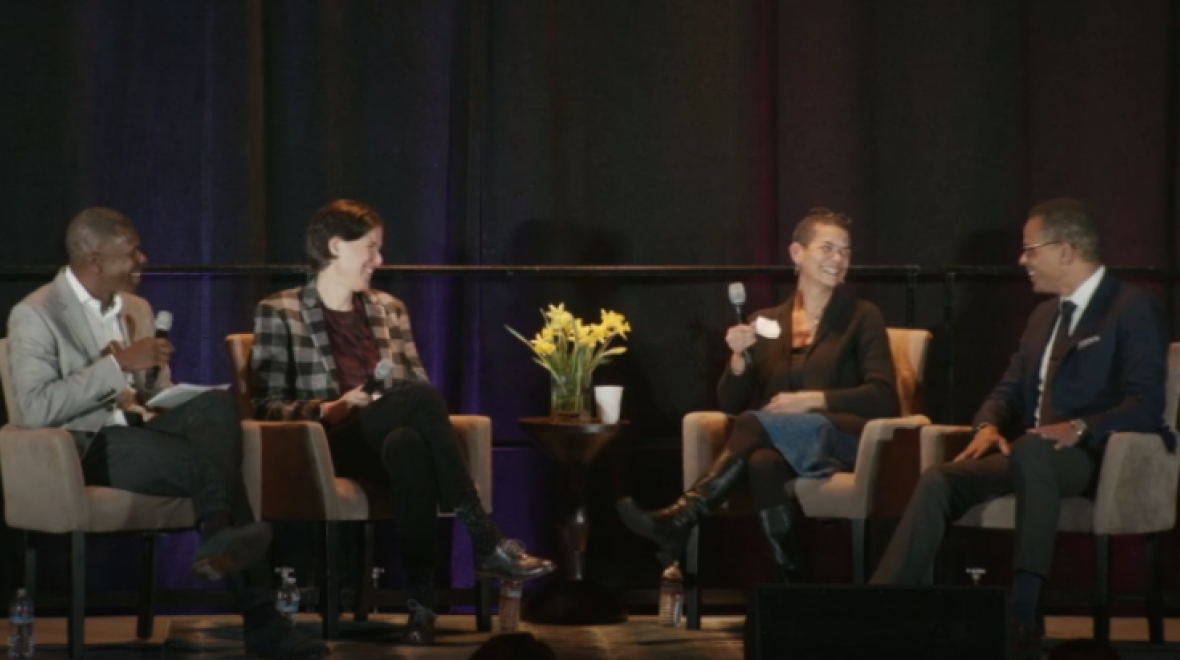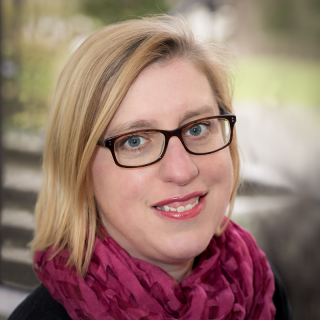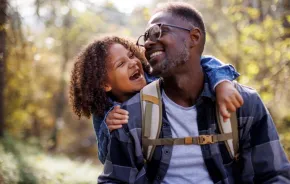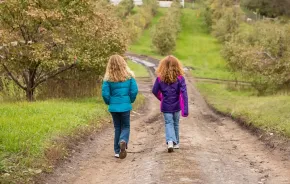
Photo:
Dr. Shawn Ginwright moderates a discussion on community trauma and child well-being with panelists Dr. Benjamin Danielson, Kaaren Andrews and Sheila Capestany. Credit: NWCF
If we don’t take care of ourselves, we’re never going to heal our children, much less our communities.
That’s one of the takeaway ideas I carried home from the NW Children’s Foundation forum, Community Trauma and Child Well-Being: Trauma-Informed Care and the Future of Healing, that took place on January 31 in Seattle. When I wondered aloud about the idea of self-care being selfish, the event’s keynote speaker was swift to disagree.
“To take care of others, we need to be committed to our own healing. It’s not self-care: It’s a whole collective movement of well-being,” said Dr. Shawn Ginwright, a leading national expert on African American youth, youth activism and youth development. “If our society is harming us, we need to collectively work on our own well-being.”
Ginwright spoke before a full house of 700 people, including experts from 240 organizations related to child advocacy, violence prevention, foster care and family support. After his talk, he moderated a panel discussion with Dr. Benjamin S. Danielson, medical director of the Odessa Brown Clinic; Kaaren Andrews, principal of the Interagency Academy; and Sheila Capestany, senior advisor for Children and Youth of King County Best Starts for Kids. Topics included healing from community trauma, and how poverty, racism and toxic stress influence all of us. Read on for insights from all the presentations that parents should consider.
People are more than their traumas
Currently, professionals who work with youth who have experienced trauma utilize a method called trauma-informed care. This method, writes Ginwright, “encourages support and treatment to the whole person, rather than [focusing] on only treating individual symptoms or specific behaviors.” Through his work with young people, he’s learned we need to expand the scope of this method.
Ginwright illustrates this by sharing an anecdote about a healing circle he led with a group of African American young men who had experienced some form of trauma. A student named Marcus said he was tired of talking about his trauma. He told Dr. Ginwright, “I am more than what happened to me. I’m not just my trauma.” Marcus wanted to talk about his dreams for the future, and the other people in the healing circle did, too. They wanted to talk about becoming computer technicians and opening auto-body shops. Marcus didn’t want his defining characteristic to be the worst thing that ever happened to him.
Don’t abandon trauma-centered care, concluded Dr. Ginwright, but incorporate asset-driven strategies that highlight possibilities for well-being. This approach acknowledges that young people are much more than the worst thing that has happened to them, and builds upon their experiences, skills and curiosity as positive traits to be enhanced.
Five principles for healing from trauma
Dr. Ginwright offers a new term to extend trauma-centered care: healing-centered engagement. The five principles for this healing-centered approach are culture, agency, relationships, meaning and aspirations, or CARMA — and they also represent great parenting principles.
Healing needs to be culturally grounded, meaning we lift up who we are in this world. Dr. Ginwright noted that his mother loved saying to him, “The blacker the berry, the sweeter the juice.” This was her antidote for internalized racism, said Dr. Ginwright, who noted that the cure is in our culture.
Agency is about helping our youth take part in micro and macro acts of change. Our relationships with our youth need to be transactional, meaning we need to connect with each other’s humanity. As caregivers, if we share some piece of ourselves, that gives our youth permission to do the same.
Meaning is about helping our youth discover who they are, where they are going and what purpose they were born to serve.
Lastly, aspiration is about helping our youth explore possibilities for their lives and figure out how to accomplish their personal goals, as well as contribute to collective goals for our society. We have a right to imagine beyond our oppressions and to dream, said Dr. Ginwright.
Capitalism is toxic, not poverty
During his talk on equity and wellness, Dr. Danielson noted that Seattle is the fifth whitest city in the country while also having several of the country’s most diverse ZIP codes. The United States has one of the greatest wealth gaps in the world, and studies show that the greater the wealth gap, the poorer the health outcomes are for everyone. Often people say that toxic poverty leads to poor health outcomes, but Dr. Danielson says we should reframe this: It’s toxic capitalism, not toxic poverty. It’s putting the value of money over the value of people.
The fact is if we raise other people up, we raise ourselves up, he says. We like to think that your issues are at my expense. But the truth is your gains are my gains, and your deficits are my deficits, too.
Adulthood is not a “trauma free” destination
We like to think of healing as a one-way street — that adults provide the healing. But Dr. Ginwright believes that healing must be considered an ongoing process for all humans. Practitioners who work with traumatized youth must proactively sustain their own healing and well-being to be effective at their jobs. And parents are no different. If we cannot be intentional about our own well-being, how can we translate and model well-being to our children?
So, how can parents start taking self-healing seriously? Begin by taking an audit of what we are doing — or not — to heal ourselves and to support our own mental and physical health. Then, Dr. Ginwright encourages, prioritize personal strategies for wellness. Parents needs to make these practices explicit to their children. By saying out loud how we take care of ourselves, we are modeling wellness strategies to our children.











